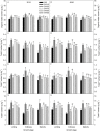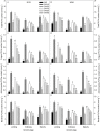Rhizosphere soil properties of waxy sorghum under different row ratio configurations in waxy sorghum-soybean intercropping systems
- PMID: 37410726
- PMCID: PMC10325085
- DOI: 10.1371/journal.pone.0288076
Rhizosphere soil properties of waxy sorghum under different row ratio configurations in waxy sorghum-soybean intercropping systems
Abstract
To overcome the continuous planting obstacle and promote the sustainable production of waxy sorghum, a two-years field experiment was performed to determine the responses of waxy sorghum rhizosphere soil properties to different row ratio configurations in waxy sorghum-soybean intercropping systems. The treatments included five row ratio configurations, which were two rows of waxy sorghum intercropped with one row of soybean (2W1S), two rows of waxy sorghum intercropped with two rows of soybean (2W2S), three rows of waxy sorghum intercropped with one row of soybean (3W1S), three rows of waxy sorghum intercropped with two rows of soybean (3W2S), and three rows of waxy sorghum intercropped with three rows of soybean (3W3S), and sole cropping waxy sorghum (SW) was used as control. The nutrients, enzyme activities, and microbes of waxy sorghum rhizosphere soil were investigated at the jointing, anthesis, and maturity stages. Results showed that rhizosphere soil properties of waxy sorghum were significantly affected by row ratio configurations of waxy sorghum intercropped soybean. Among all treatments, the performances of rhizosphere soil nutrients contents, enzymes activities, and microbes contents were 2W1S > 3W1S > 3W2S > 3W3S > 2W2S > SW. Compared to SW treatment, the 2W1S treatment increased the organic matter, total N, total P, total K, gram-negative bacteria phospholipid fatty acids (PLFAs), and gram-positive bacteria PLFAs contents and catalase, polyphenol oxidase, and urease activities by 20.86%-25.67%, 34.33%-70.05%, 23.98%-33.83%, 44.12%-81.86%, 74.87%-194.32%, 81.59-136.59%, 91.44%-114.07%, 85.35%-146.91%, and 36.32%-63.94%, respectively. Likewise, the available N, available P, available K, total PLFAs, fungus PLFAs, actinomycetes PLFAs, and bacteria PLFAs contents under the 2W1S treatment were 1.53-2.41, 1.32-1.89, 1.82-2.05, 1.96-2.91, 3.59-4.44, 9.11-12.56, and 1.81-2.71 times than those of SW treatment, respectively. Further, the determining factors of soil microbes were total K, catalase, and polyphenol oxidase for total microbes, bacteria, and gram-negative bacteria, total P and available K for fungus, available N, available K, and polyphenol oxidase for actinomycetes, and total K and polyphenol oxidase for gram-positive bacteria. In conclusion, the 2W1S treatment was the optimal row ratio configuration of waxy sorghum intercropped with soybean, which can improve the rhizosphere soil quality and promote the sustainable production of waxy sorghum.
Copyright: © 2023 Shao et al. This is an open access article distributed under the terms of the Creative Commons Attribution License, which permits unrestricted use, distribution, and reproduction in any medium, provided the original author and source are credited.
Conflict of interest statement
The authors have declared that no competing interests exist.
Figures




Similar articles
-
Effects of Nitrogen Application Rate on Nitrogen Uptake and Utilization in Waxy Sorghum Under Waxy Sorghum-Soybean Intercropping Systems.Plants (Basel). 2025 May 3;14(9):1384. doi: 10.3390/plants14091384. Plants (Basel). 2025. PMID: 40364413 Free PMC article.
-
Changes in Nutrient Accumulation and Transportation of Waxy Sorghum in Waxy Sorghum-Soybean Intercropping Systems Under Different Row Ratio Configurations.Front Plant Sci. 2022 Jul 22;13:921860. doi: 10.3389/fpls.2022.921860. eCollection 2022. Front Plant Sci. 2022. PMID: 35937366 Free PMC article.
-
Dynamic changes of rhizosphere soil bacterial community and nutrients in cadmium polluted soils with soybean-corn intercropping.BMC Microbiol. 2022 Feb 15;22(1):57. doi: 10.1186/s12866-022-02468-3. BMC Microbiol. 2022. PMID: 35168566 Free PMC article.
-
Maize/peanut intercropping improves nutrient uptake of side-row maize and system microbial community diversity.BMC Microbiol. 2022 Jan 7;22(1):14. doi: 10.1186/s12866-021-02425-6. BMC Microbiol. 2022. PMID: 34996375 Free PMC article.
-
P for two, sharing a scarce resource: soil phosphorus acquisition in the rhizosphere of intercropped species.Plant Physiol. 2011 Jul;156(3):1078-86. doi: 10.1104/pp.111.175331. Epub 2011 Apr 20. Plant Physiol. 2011. PMID: 21508183 Free PMC article. Review. No abstract available.
Cited by
-
Impact of Sugarcane-Pumpkin Intercropping on Soil Microbial Diversity.Microorganisms. 2025 Jul 20;13(7):1703. doi: 10.3390/microorganisms13071703. Microorganisms. 2025. PMID: 40732212 Free PMC article.
-
Effects of Nitrogen Application Rate on Nitrogen Uptake and Utilization in Waxy Sorghum Under Waxy Sorghum-Soybean Intercropping Systems.Plants (Basel). 2025 May 3;14(9):1384. doi: 10.3390/plants14091384. Plants (Basel). 2025. PMID: 40364413 Free PMC article.
-
Carbon Nanodot-Microbe-Plant Nexus in Agroecosystem and Antimicrobial Applications.Nanomaterials (Basel). 2024 Jul 25;14(15):1249. doi: 10.3390/nano14151249. Nanomaterials (Basel). 2024. PMID: 39120354 Free PMC article. Review.
References
-
- Wang C, Zhou LB, Zhang GB, Xu Y, Zhang LY, Gao X, et al.. Optimal fertilization for high yield and good quality of waxy sorghum (Sorghum bicolor L. Moench). Field Crops Res. 2017; 203:1–7.
-
- Wang C, Zhou LB, Zhang GB, Xu Y, Zhang LY, Gao X, et al.. Drought resistance identification and drought resistance indices screening of liquor-making waxy sorghum resources at adult plant stage. Sci. Agric. Sin. 2017; 50:1388–1402. Chinese.
-
- Wang C, Zhou LB, Gao X, Zhang GB, Cheng B, Cao N, et al.. Genetic diversity and population structure analysis of grain-use sorghum based on genotyping by sequencing technology. J. Plant Genet. Res. 2019; 20:667–684. Chinese.
-
- Wang C, Zhou LB, Zhang GB, Xu Y, Gao X, Jiang N, et al.. Effects of sowing time and growing density on agronomic traits, grain yield, and grain quality of waxy sorghum cultivar Hongliangfeng 1. J. Agric. Sci. 2019; 11:12–21.
MeSH terms
Substances
LinkOut - more resources
Full Text Sources

